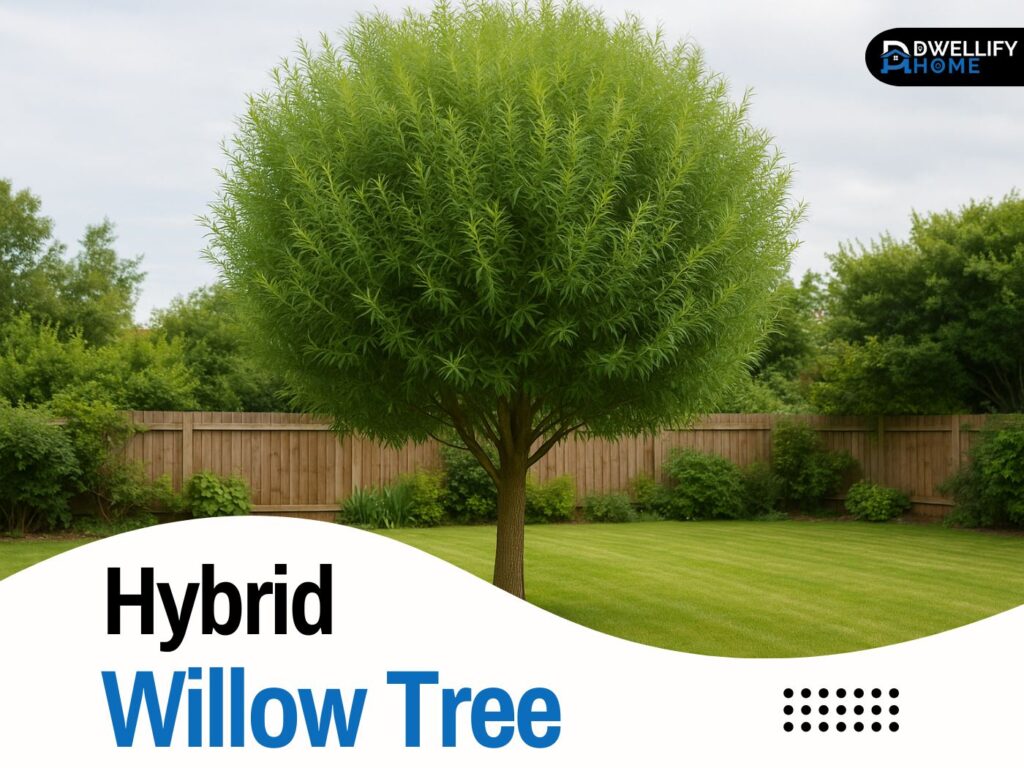If you’ve ever dreamed of creating a lush green wall of privacy in your backyard, the Hybrid Willow Tree might just be your new best friend. This fast-growing beauty is known for its incredible growth rate, soft rustling leaves, and the kind of natural charm that turns an ordinary yard into a peaceful retreat.
I’ve planted a few hybrid willows over the years, and let me tell you, watching them grow feels like watching time-lapse nature in real life. Within just one or two seasons, you can go from bare ground to a living, breathing privacy screen that sways gently in the breeze. But before you rush out to plant one, there are a few things you’ll want to know — both the good and the not-so-good.
Snippet-Ready Definition:
A Hybrid Willow Tree is a fast-growing cross between willow species, known for its lush foliage, quick privacy screening, and adaptability to different soils, making it perfect for landscaping and erosion control.
Mission Statement:
At Dwellify Home, our mission is to inspire homeowners and garden lovers to create natural, sustainable, and beautiful outdoor spaces. We believe that trees like the Hybrid Willow Tree aren’t just plants — they’re living art that brings peace, privacy, and purpose to every yard.
What Exactly Is a Hybrid Willow Tree
Here’s the thing — hybrid willows aren’t just any ordinary willow. They’re a cross between two willow species, usually the Salix matsudana (Chinese willow) and Salix alba (white willow). The result is a tree that combines the best of both worlds — strength, adaptability, and impressive speed when it comes to growth.
These trees are often sold under names like Austree Hybrid Willow, Aussie Hybrid Willow, or simply Willow Hybrid Tree. You might even see them advertised as Fast-Growing Hybrid Willow Trees or Willow Hybrid Tree Hedges, and that’s no exaggeration — they really do live up to the hype in the growth department.
Gardeners and landscapers love them for their versatility. Whether you want to block out a neighboring building, control erosion on a slope, or just add a touch of shade to your backyard, a hybrid willow can handle the job.
Growth Rate and Appearance
Let’s talk about speed — because that’s what really sets this tree apart. A Hybrid Willow Tree can grow an incredible 6 to 10 feet per year under the right conditions. That’s fast enough to give you noticeable shade and privacy in just one growing season.
At full maturity, these trees usually reach between 30 and 75 feet tall, depending on the variety and pruning. Their leaves are long, slender, and a deep glossy green that dances with the wind. The branches grow upright but with a soft, flowing texture that feels almost calming when you look at them.
If you’re comparing options, the hybrid willow easily outpaces trees like the Hybrid Poplar Tree, Taylor Juniper, or even Emerald Green Arborvitae when it comes to speed. However, that rapid growth comes with a few tradeoffs, which we’ll get into soon.
Lifespan: How Long Do Hybrid Willows Live
Here’s something that surprises many new gardeners — hybrid willows don’t live forever. On average, they last about 30 to 50 years, though some varieties, like the Austree, may have shorter lifespans of around 15 years.
Why so short? The answer lies in their speed. Fast-growing trees often have softer wood and weaker branch structures. Over time, this can lead to breakage, disease, or decay. However, with proper care — regular pruning, consistent watering, and pest prevention — you can help extend their lifespan significantly.
If you want something quick to establish a green space, the hybrid willow is perfect. But if you’re looking for a legacy tree to last generations, you might want to pair it with something more long-lived later on.
The Pros and Cons of Planting Hybrid Willow Trees
Every tree has its perks and pitfalls, and the hybrid willow is no exception. Here’s a balanced look from someone who’s learned through both success and a few messy yard cleanups.
The Pros
- Rapid Growth: You’ll get instant gratification — a dense, green screen in a single season.
- Erosion Control: The roots are strong and perfect for holding soil on slopes or riverbanks.
- Adaptability: They thrive in a variety of soils, from clay to loam.
- Flood Tolerance: These trees can handle wet areas where many others would struggle.
- Beautiful Foliage: The long, slender leaves create a graceful, soft movement in the wind.
The Cons
- Weak Wood: The branches can snap easily during strong storms.
- Aggressive Roots: They’ll chase water sources and may interfere with plumbing or foundations.
- High Water Needs: They love moisture and won’t do well in dry or sandy soil without irrigation.
- Maintenance: Regular pruning is a must to keep the tree strong and tidy.
- Shorter Lifespan: They live fast and, unfortunately, die young compared to slower species.
If you plant wisely and give them space to spread, the pros easily outweigh the cons. Just don’t plant them near your driveway or septic system.
Growing Conditions and Best Climate Zones
Hybrid willows are tough cookies when it comes to climate. They’re hardy in USDA Zones 4 through 9, which covers a big portion of North America. That means they can handle temperatures as low as –30°F in winter and still bounce back strong in spring.
They love full sun — ideally 6 to 8 hours a day. The more sunlight they get, the faster they’ll grow. As for soil, they’re not picky. Whether it’s heavy clay, moist loam, or sandy soil, hybrid willows can adapt. Still, they perform best in well-drained soil that stays evenly moist.
If you’re planting them in dry regions, set up a regular watering schedule or consider drip irrigation. Hybrid willows are thirsty, and they’ll show stress quickly if the ground dries out too much.
How to Plant a Hybrid Willow Tree
Planting a hybrid willow isn’t rocket science, but it does require a little planning. Here’s a quick breakdown based on what’s worked best in my own yard.
Step 1: Choose the Right Spot
Pick a sunny location with plenty of room — these trees spread fast. Keep them at least 50 feet away from homes, water pipes, and septic systems. If you’re creating a living fence, plant them about 5 to 10 feet apart for a dense wall effect.
Step 2: Prepare the Soil
Loosen the soil, remove rocks or weeds, and mix in compost. Good drainage is key — soggy soil can lead to root rot.
Step 3: Plant and Water
Dig a hole about twice the width of the root ball. Place the tree in, backfill, and water deeply. Add mulch around the base to lock in moisture.
Step 4: Early Care
For the first few months, water frequently. Once established, they’ll need less attention, but don’t ignore them completely. A little care in the first year sets the stage for decades of healthy growth.
Caring for a Hybrid Willow Tree
Once your hybrid willow is in the ground, the real fun begins. They grow fast — sometimes too fast — so maintenance matters.
- Pruning: Cut away weak or crossing branches once or twice a year. This strengthens the structure and reduces storm damage.
- Watering: Deep water weekly, especially during dry spells.
- Fertilizing: A balanced fertilizer in spring can boost growth, but they usually thrive without heavy feeding.
- Pest & Disease Control: Watch out for cankers, rust, and willow borers. Catching issues early keeps the tree healthy.
- Winter Prep: Mulch the base and remove dead branches before winter to prevent breakage from snow and ice.
A well-cared-for willow looks alive even in dormancy — the bark stays flexible, and buds swell quickly once spring returns.
Hybrid Willow Tree in Winter
Many people ask me, “Do hybrid willow trees survive the winter?” Absolutely — as long as they’re planted in the right zone. During winter, they lose their leaves and go dormant, storing energy for spring. The branches might look bare, but don’t worry, it’s just their way of resting.
In colder regions, you can protect younger trees by wrapping the trunk with burlap or adding extra mulch at the base. Once they mature, they can easily handle subzero temperatures without much help. Come spring, you’ll see new buds sprouting like nothing ever happened.
Uses and Benefits in Landscaping
Here’s where the hybrid willow really shines — versatility. These trees are the landscaper’s secret weapon for creating functional beauty.
Living Fence or Privacy Screen
If you want to replace a dull wooden fence with something alive, hybrid willows are unbeatable. Plant them in a row, trim them annually, and within a year or two, you’ll have a natural green wall that blocks noise and wind.
Windbreak and Erosion Control
On farms or open properties, they make perfect windbreaks. Their roots lock soil in place, preventing erosion on slopes or near water.
Shade and Beauty
I planted one near a backyard patio, and within two summers, it provided shade that made outdoor lunches bearable. Their gentle movement in the breeze adds a soothing atmosphere that no metal or vinyl fence can match.
Where to Buy Hybrid Willow Trees
You can find Hybrid Willow Trees for sale at most online nurseries or local garden centers. When buying, check for:
- Healthy, flexible stems
- Moist root balls (not dry or brittle)
- Even leaf color and no signs of fungus
Reputable suppliers often sell Austree Hybrid Willow Trees or Fast Growing Willow Hybrid Trees with live-arrival guarantees. If you’re planting a large area, look for bulk pricing — you can usually save by ordering bundles.
Expert Tips and Common Mistakes to Avoid
Over the years, I’ve seen a few gardeners make simple mistakes that cause big headaches later. Here’s how to avoid them:
- Don’t plant too close to structures — roots can become a problem.
- Don’t ignore pruning — fast growth means you’ll need to shape it regularly.
- Don’t skip watering — especially in the first year.
- Avoid overly dry, sandy soils without irrigation.
- Don’t assume hybrid willows are maintenance-free — they’re fast, but they need care.
Here’s a pro tip: if you’re creating a living fence, alternate the spacing slightly in a zigzag pattern. It creates a thicker, more natural-looking screen once they fill in.
Environmental Impact and Eco Value
Hybrid willows aren’t just good-looking — they’re eco-friendly too. Their dense foliage absorbs carbon dioxide and releases oxygen efficiently. Plus, their strong root systems help prevent erosion and manage stormwater runoff naturally.
They also attract birds, bees, and butterflies, bringing biodiversity to your garden. Just remember that their roots can spread aggressively, so plant responsibly and maintain them regularly.
Comparing Hybrid Willow with Other Trees
Wondering how hybrid willows stack up against other fast growers? Here’s a quick breakdown:
- Hybrid Willow vs Hybrid Poplar: Willows grow faster and denser, while poplars tend to have cleaner shapes but shorter lives.
- Hybrid Willow vs Taylor Juniper: Junipers are evergreen and lower maintenance, but they can’t match the willow’s growth speed.
- Hybrid Willow vs Emerald Green Arborvitae: Arborvitae stay green year-round but grow slower and need precise spacing for thick coverage.
If you want a lush, natural look fast, the hybrid willow is hands-down the better choice.
Comparison Table: Hybrid Willow vs Other Fast-Growing Trees
| Feature | Hybrid Willow Tree | Hybrid Poplar Tree | Emerald Green Arborvitae | Taylor Juniper |
| Growth Rate | 6–10 ft per year | 5–8 ft per year | 1–2 ft per year | 1–2 ft per year |
| Lifespan | 30–50 years | 20–30 years | 40+ years | 50+ years |
| Best For | Privacy, erosion control | Quick shade | Evergreen fence | Narrow screens |
| Maintenance | Moderate pruning | Moderate | Low | Low |
| Root Behavior | Aggressive, wide | Moderate | Compact | Compact |
| Cold Tolerance | −30°F (Zones 4–9) | −25°F | −40°F | −35°F |
Quick Step-by-Step Guide: How to Plant a Hybrid Willow Tree
- Pick the right spot — Choose full sun and plant 50 ft from structures or pipes.
- Prepare the soil — Loosen, enrich with compost, and ensure good drainage.
- Dig and plant — Make a wide hole, set the root ball level, and backfill firmly.
- Water deeply — Keep soil moist for the first few months.
- Mulch the base — Retains moisture and protects roots.
- Prune annually — Shape the canopy and remove weak or dead branches.
Frequently Asked Questions
How fast does a hybrid willow tree grow?
About 6 to 10 feet per year under good conditions.
How tall does it get?
Anywhere from 30 to 75 feet at maturity.
Can it survive cold winters?
Yes, it’s hardy in zones 4 through 9 and can handle freezing temperatures.
Is it invasive?
It can be if planted too close to pipes or buildings, but responsible placement solves that problem.
How long does it live?
Typically 30 to 50 years with good care.
Can I plant hybrid willows near my house?
It’s best to keep them at least 50 feet away from foundations and septic systems.
Final Thoughts: Should You Plant a Hybrid Willow Tree
So, should you go for it? If you want fast privacy, quick shade, and a tree that grows like it’s on a mission, the Hybrid Willow Tree is an excellent choice. Just give it space, keep up with pruning, and enjoy watching your landscape transform.
The best part is that you don’t need to be a pro gardener to grow one. With a bit of care and attention, this tree rewards you with beauty, greenery, and a peaceful vibe that makes any outdoor space feel alive.
And if you’re anything like me, you’ll find yourself sitting under its branches one summer afternoon, smiling at how something so simple could grow into something so stunning.
Disclaimer
This article is for educational and informational purposes only. Growing conditions vary by region, and tree behavior can differ based on soil, water, and climate. Always consult a certified arborist or local gardening expert before planting near buildings, plumbing lines, or septic systems.

I’m Bilal, the founder of Dwellify Home. With 6 years of practical experience in home remodeling, interior design, and décor consulting, I help people transform their spaces with simple, effective, and affordable ideas. I specialize in offering real-world tips, step-by-step guides, and product recommendations that make home improvement easier and more enjoyable. My mission is to empower homeowners and renters to create functional, beautiful spaces—one thoughtful update at a time.




